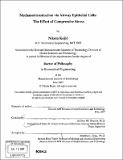Mechanotransduction via airway epithelial cells : the effect of compressive stress
Author(s)
Kojić, Nikola, 1978-
DownloadFull printable version (37.69Mb)
Other Contributors
Harvard University--MIT Division of Health Sciences and Technology.
Advisor
Jeffrey M. Drazen.
Terms of use
Metadata
Show full item recordAbstract
A classic finding in asthma is a change in the structural organization of the airway epithelium. This complex process known as airway remodeling is not fully understood, and we believe that the forces accompanying airway constriction activate the epithelium and contribute to airway remodeling. To better understand this mechanotransduction mechanism we used an in vitro system of cultured normal human bronchial epithelial cells that could simulate compressive stresses experienced by the epithelium during bronchoconstriction. The application of a transcellular pressure gradient (10-50cmH20) for 10 minutes resulted in transient activation of the epidermal growth factor receptor (EGFR) - MAP kinase (ERK) signaling pathway. Furthermore, specialized real-time high-speed imaging revealed an exponential decrease in the volume of the compliant lateral intercellular space (LIS) separating neighboring cells. The measured LIS volume collapse curves were directly inputted into 2-D and 3-D numerical finite element models, whose output was EGFR-ligand concentration dynamics in the LIS. (cont.) During the first three minutes under pressure, the calculated increase in ligand concentration (specifically HB-EGF, which is made by the cells and shed into the LIS, thereby constituting an autocrine loop with the EGFR) matched the measured phosphorylated EGFR (pEGFR) dynamics. The model thus provided crucial insight into how an observed change in LIS geometry esulted in activation of the EGFR signaling pathway. This insight, coupled to EGFR signaling models, could one day be applied to the design of novel pharmacogenetic therapeutics aimed at preventing airway over-activation and potentially hindering airway remodeling progression in asthmatic patients.
Description
Thesis (Ph. D.)--Harvard-MIT Division of Health Sciences and Technology, 2007. "June 2007." Includes bibliographical references (leaves 153-157).
Date issued
2007Department
Harvard University--MIT Division of Health Sciences and TechnologyPublisher
Massachusetts Institute of Technology
Keywords
Harvard University--MIT Division of Health Sciences and Technology.